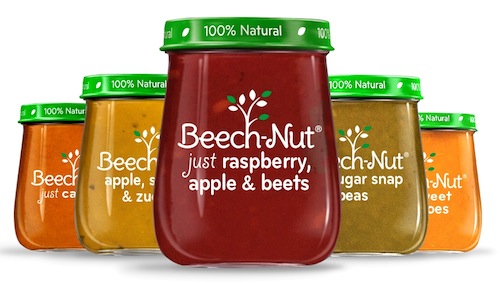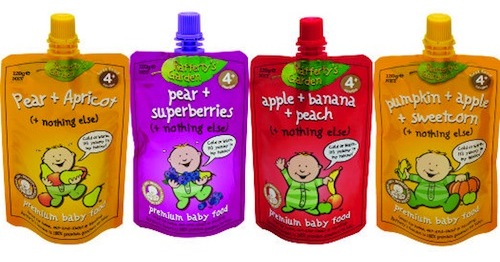Two baby and toddler food companies: Beech-Nut is 123 years old, Rafferty’s Garden is 7. Both lead with peak nutrition claims. Beech-Nut makes glass packaging part of this. Rafferty’s Garden uses flexible pouches. Let’s examine both of their stories.
Beech-Nut is an American baby food brand, a subsidiary of Hero AG of Lenzburg, Switzerland since 2005. It began as Beech-Nut Packing Company in 1899. Engineers from Beech-Nut patented the first vacuum jar with a design that included a gasket and top that could remain intact in transit and it became a standard of the industry. Beech-Nut has been manufacturing baby food since 1931.
Andy Dahlen, vice president of marketing and sales at Beech-Nut Nutrition Company commented, “It was a brand built around competency in packaging. In 1931, Beech-Nut was the first to put baby food in a vacuum-packed container. That was an innovation at the time. Throughout the history of the brand, the company has been a leader in terms of being the first to remove any additional salts and sugars, and the first to launch a stage eating system for baby food, where the textures and the products were designed to meet babies’ needs as they grew.”
In 2014, the no.2 baby food brand in the US changed both its products and its packaging. Why? To win back the one third of mums in the US who had abandoned pre-made baby food. “Real food for babies” was born. The transformation began in 2012 with a move to simpler, 100% natural foods.

Beech-Nut worked with a proprietary supplier to develop gentle cooking technology, a method that ensures the freshness of the fruits and vegetables, without the addition of excess water or preservatives. During cooking, Beech-Nut uses indirect heat similar to a double-boiler to preserve the colour, texture, and flavour of the products.
The changes had to be communicated in the packaging. That job fell to design company, Bluedog. “We could not incrementally change our design. We needed something transformational,” Dahlen noted.
Bluedog founder and president, Michelle Hayward explained the changes, “We found there were key themes of purity, connection, and singularity. If you think about what those words mean, you really start to think about the fact that mom has a job to protect her child’s innocence. That’s why she is in the kitchen making the food, that’s why she is deliberate when it comes to anything that goes on that child’s skin or in that child’s mouth. She wants as little as possible to get between the raw ingredients and the final pureed food.
“We took that quite literally. It’s one of the reasons that glass was an imperative for this project and why we developed the brand identity the way we did. What we wanted mum to see when she was turning her cart and going down the aisle were the vibrant colours and textures of the products.”
Beech-Nut is now "the baby food brand of just fruit and vegetables". Nothing else added. Not even water.
The 4.25 oz (120g) custom glass jar was was a joint effort between glass manufacturer, Owens-Illinois, and the project’s design company, Bluedog Design. The jar’s development took up that about one third of the overall product/project development timeline. “That included label and closure, all of which would have to work on our production line at the required rates…Glass is one of the safest, purest containers to preserve the integrity of the food. It maintains the integrity of the food better than anything else. It also allows us in the most transparent way to showcase the food to the greatest degree possible. We remain very committed to glass.”
Glass is also recyclable, which is important to Millenials, who are the ones about to have babies.
Bluedog selected a clear, pressure-sensitive label to decorate the package. This provides a clear view of the product and reinforces the idea of the brand’s transparency. There is the least content possible on the label to reflect the simplicity of the product. The jar’s honeypot shape adds a homemade, premium appearance. The design allows the jar to nestle in the hand and provides space for a spoon to wrap 360 degree around the inside to extract all the food.
Glass does not absorb food colours or smells, so the food inside keeps its natural taste, smell, and appearance. The glass jar for Beech-Nut is designed to stack on shelves at retail and in the home.
“We are taught in the world of package design that we need to scream our equities as loudly as we can—from 30 feet, from 15 feet, from 10 feet. We broke the rules here. What we really wanted to do is reinforce the food. You see the food; it’s glorious, it’s beautiful, it’s vibrant, it’s textured. It’s real food, and we made room for that food to speak to that authenticity and relevancy on its own,” Hayward concluded.
To produce the new brand, Beech-Nut built a US$10 million state-of-the-art production line at its Amsterdam New York facility. It is the world's first LEED-certified baby food production facility.
The packaging is essentially a straight-flow layout beginning in the filling area that is segregated from the processing and downstream packaging operations.
Chris Darling, director of engineering, explained the equipment decisions, “We considered many aspects to shape the overall strategy of the line. These included changeover, cleanability, ease of use and familiarity with vendors. All testing and integration to the existing line was completed in advance of the system’s arrival.”
One of the key pieces of new equipment was a new Krones Autocol labeller to produce a clean "no-label" look. The production line operates with a ‘pull system” and so the labeller is the pace setter. Other major components include a tray packer, X-ray inspection and a palletiser. Line controls and seamless integration were another key aspect. The line controls use hardware and software systems provided by Rockwell Automation, which were integrated by Beech-Nut directly.
Last, but not least, is the final component for the primary packaging, the closure, which Dahlen singles out as “something that would also help differentiate the products. We looked at different colours and felt that the green twist-off, vacuum top closure from Crown Holdings best communicated the product positioning.”
The product shelf life is 18 months.
The secondary packaging has also changed. The new shrink-wrapped 2x5, 10-count tray offers a 3-lip, 1-side open design and is shelf/retail ready. This, too, is a first for Beech-Nut. The less-than-half-height tray is shelved with the no-flap side facing out to enable easy access to the jars without a flap needing to be cut.
Watch the story of Beech-Nut baby food's relaunch here:
Rafferty’s Garden launched in Australia in October 2007. At the time, all “wet” baby food in Australia was supplied in cans and glass jars. Heinz had an approximate 90% share of the supply of wet infant food in Australia (by value), all of it sold in cans and glass jars. Rafferty’s Garden’s wet food entered the market with a clear point of difference – its packaging. It was the only baby food brand offering wet baby food in pouch and pouch-and-spout packaging (these are still the only two forms its uses). Its wet food ranges are presented as ‘Smooth’, ‘Puree’, ‘Lumpy’, ‘Yoghurt Smoothy’ and ‘Flavours of the World.’’ The company also makes “dry” baby food - rusks, snack bars and freeze dried fruits.
In Australia, baby food in cans is sold at the lowest price and tends to be consumed at home. Baby food in resealable glass jars is more expensive and is consumed in and out of the home. Baby food in pouches is more expensive again. it is light and unbreakable, so easy to carry and use on the go.
Heinz and Rafferty’s other competitors, McCallums and Organic Bubs, started using pouch-and-spout packaging in 2010. By that time, Rafferty’s Garden had achieved a share of approximately 25% of the supply of wet infant food (by value) across all packaging formats. Since Rafferty’s Garden entered the market, every new entrant for the supply of wet infant food has used the pouch-and-spout packaging format.
During 2012, three new “wet” baby food brands appeared - Ella’s Kitchen started supplying wet baby food to Coles under an exclusive arrangement, Woolworths launched its own ‘Baby Macro’ brand and ALDI introduced its ‘Mamia’ and ‘Baby’s Own’ brands.

Rafferty's Garden’s packaging was seen as a significant innovation in 2007. The company has also led innovation in other non-price aspects of wet baby food, such as branding, packaging design, product quality and flavours.
Other baby food companies have responded either by imitating them (notably by adopting pouch-and-spout packaging) or by seeking their own points of difference.
Heinz and Rafferty’s Garden are now the two largest suppliers of wet baby food by a significant margin. When Heinz tried to buy Rafferty’s Garden in February 2013, the two brands owned 78% of the wet baby food market. Cussons bought Rafferty’s Garden in July of that year, by which time Rafferty's Garden held a 40% share of the wet baby food market, as well as growing shares in the infant dry and snacks market.
While it was the packaging that differentiated the product on retail shelves, the impetus behind the company was its founder, Adrian Pike’s, observation that that so many of kids weren’t getting the nutrition they should be. Rafferty’s Garden became the brand that only used the freshest, most premium ingredients, with no added sugar, salt, preservatives, additives or anything artificial. And today it still upholds its ‘Nothing else’ mantra.
The production methods were developed to ensure that every meal adhered to the company’s unwavering aim to provide healthy nutritious meals. It adopted a process that allows food to be cooked only once at lower temperatures to retain more of their natural flavours and nutritional values.
“When combined with our unique packaging process, this also ensures our meals can achieve a twelve month shelf life,” the company adds.
“Our smooth range is produced using hot fill. The products are cooked for the minimum time required, using the natural acidity of the ingredients as preservatives, while locking in the natural goodness and flavours. This is a process that has been used for centuries by people when preserving fruit and vegetables at home.
“Our puree and lumpy ranges are prepared and cooked in large kettles before transferring into our pouches for a final cooked process using pressurised heat equipment. The reduced cooking time and our flexible pouches help retain the natural goodness of the ingredients.
“And did you know that the minimal cooking time is the primary advantage of products make in flexible pouches vs cans and jars,” Rafferty’s Garden concludes.
Rafferty’s Garden packaging is printed with toluene free inks, use aliphatic (not aromatic) adhesives and interiors are made from food contact-approved cast polypropylene (CPP), which does not contain BPA. The pouch layers are polyester, nylon, aluminium foil and polyethylene. Rafferty’s Garden states that each is recyclable but because Australia does not currently have the technology to separate these materials before they are recycled they are ranked plastics code “7” or other. “Until this technology is available, our high barrier packaging used for sensitive products will have to end up in landfill.”
Nestle has developed a range of shelf-stable, microwavable, ready meals for babies and toddlers, called NaturNes (not yet available in Australia). An almost identical range was produced in a Nestle plant in France from 1998 to 2009. But it was withdrawn until Nestlé’s packaging engineers came up with a way to better automate the way it was packaged. Read that story on PKN next week.





